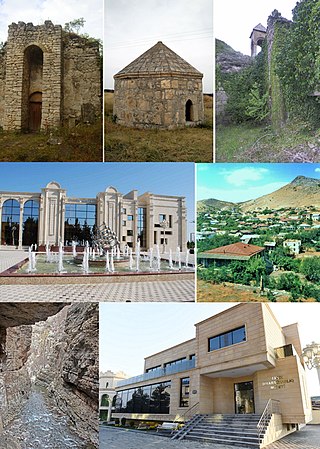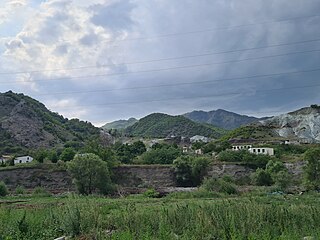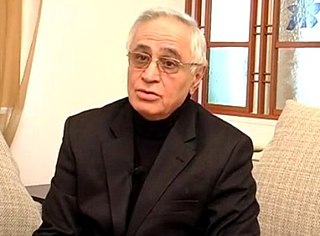Azerbaijan is administratively divided into 66 districts and 11 cities that are subordinate to the Republic. Out of these districts and cities, 7 districts and 1 city are located within the Nakhchivan Autonomous Republic. The districts are further divided into municipalities.

Kalbajar District is one of the 66 districts of Azerbaijan. It is located in the west of the country and belongs to the East Zangezur Economic Region. The district borders the districts of Lachin, Khojaly, Agdam, Tartar, Goranboy, Goygol and Dashkasan districts of Azerbaijan, as well as the Gegharkunik and Vayots Dzor provinces of Armenia. Its capital and largest city is Kalbajar. As of 2020, the district had a nominal population of 94,100.

Tartar District is one of the 66 districts of Azerbaijan. It is located in the west of the country and belongs to the Karabakh Economic Region. The district borders the districts of Kalbajar, Goranboy, Yevlakh, Barda, and Aghdam. Its capital and largest city is Tartar. As of 2020, the district had a nominal population of 104,700. In March 2023, Azerbaijan began resettling the part of the district that was previously controlled by Armenian forces. Resettlement of the village by Azerbaijan began in March 2023, with 20 families moving back to Talish.
The Battle of Kalbajar took place in March and April 1993, during the First Nagorno-Karabakh War. It resulted in the capture of the Kalbajar District of Azerbaijan by Armenian military forces.

Aghdam is a ghost city and the nominal capital of the Aghdam District of Azerbaijan. Founded in the 18th century, it was granted city status in 1828 and grew considerably during the Soviet period. Aghdam lies 26 km from Stepanakert at the eastern foot of the Karabakh Range, on the outskirts of the Karabakh plain.

Sotk is a village in the Vardenis Municipality of the Gegharkunik Province of Armenia, well known for its gold mines.

Qamışlı is a village in the Kalbajar District of Azerbaijan. It is situated along the Levçay river.

Rahim Hasan oghlu Gaziyev was Azerbaijani Defense Minister in 1992–1993, in the turmoil of the First Nagorno-Karabakh War, and later a political prisoner.

The Armenian-occupied territories surrounding Nagorno-Karabakh were areas of Azerbaijan, situated around the former Nagorno-Karabakh Autonomous Oblast (NKAO), which were occupied by the ethnic Armenian military forces of the breakaway Republic of Artsakh with military support from Armenia, from the end of the First Nagorno-Karabakh War (1988–1994) to 2020, when the territories were returned to Azerbaijani control by military force or handed over in accordance to the 2020 Nagorno-Karabakh ceasefire agreement. The surrounding regions were seized by Armenians under the justification of a "security belt" which was to be traded for recognition of autonomous status from Azerbaijan.

The Second Nagorno-Karabakh War was an armed conflict in 2020 that took place in the disputed region of Nagorno-Karabakh and the surrounding occupied territories. It was a major escalation of an unresolved conflict over the region, involving Azerbaijan, Armenia and the self-declared Armenian breakaway state of Artsakh. The war lasted for 44 days and resulted in Azerbaijani victory, with the defeat igniting anti-government protests in Armenia. Post-war skirmishes continued in the region, including substantial clashes in 2022.
2014 Kalbajar incident refers to the crossing of a small group of Azerbaijanis into Kalbajar district, their subsequent capture and conviction for murder and sabotage by the Republic of Artsakh. In July 2014, three ethnic Azerbaijanis crossed Nagorno-Karabakh Line of Contact in to Kalbajar District, then controlled by breakaway Republic of Artsakh forces. This was followed by disappearance of 17-year-old local Smbat Tsakanyan who was later found dead from gunshot wounds and who was last seen walking with the Azerbaijanis in a video used as evidence in the trial. The Azerbaijanis were detained for "reconnaissance operations in the area on orders from Azerbaijan’s intelligence service," as well as kidnapping and killing of Tsakanyan. One of the Azerbaijanis named Hasanov attacked Major Sargis Abrahamyan and his companion Karine Davtyan on the road from Vardenis to Kalbajar, killing the first and wounding the latter, himself subsequently killed in firefight with Artsakh Defence Army servicemen. The Artsakh forces detained and convicted Asgarov and Guliyev for murdering Tsakanyan while Hasanov was posthumously convicted for killing Abrahamyan and wounding Davtyan. Asgarov and Guliyev pleaded not guilty, claiming they had crossed to Kalbajar "to visit their relatives' graves". The incident may have been a trigger of the 2014 Armenian–Azerbaijani clashes in late July and early August that year. After ceasefire agreement ended the 2020 Nagorno-Karabakh war, Armenia returned Asgarov and Guliyev to Azerbaijan, as part of a prisoner exchange.
The casualties of the Second Nagorno-Karabakh War, fought between Armenia, the self-proclaimed Republic of Artsakh internationally recognized as the territory of Azerbaijan and Azerbaijan, officially number in the low thousands. According to official figures released by the belligerents, Armenia and Artsakh lost 3,825 troops, with 187 servicemen missing in action, while Azerbaijan lost 2,906 troops, with 6 missing in action. The Syrian Observatory for Human Rights reported the deaths of 541 Syrian fighters or mercenaries fighting for Azerbaijan. However, it is believed that the sides downplayed the number of their own casualties and exaggerated the numbers of enemy casualties and injuries.

The Battle of Shusha was the final and decisive battle of the Second Nagorno-Karabakh War, fought between the armed forces of Azerbaijan and the self-proclaimed Republic of Artsakh, militarily supported by Armenia, over the control of the city of Shusha. The battle is considered one of the bloodiest battles of the war.
Babak Matlab oglu Samidli was an Azerbaijani military officer, and a colonel serving in the Azerbaijani Armed Forces. He was deputy commander of the 1st Army Corps.

2020 Baku Victory Parade was held on 10 December, in Azadliq Square, Baku, capital of Azerbaijan. It was held in honor of the Azerbaijani victory during the Second Nagorno-Karabakh war, officially described as the Patriotic War in Azerbaijan. The parade was held with 3,000 military servicemen who distinguished themselves during the war marched alongside military equipment, unmanned aerial vehicles and aircraft, as well as Armenian war trophies, and Turkish soldiers and officers, while navy vessels performed maneuvers in the nearby Bay of Baku, and jets and helicopters flew above the city. Turkish President Recep Tayyip Erdoğan, a key ally of Azerbaijan in the war, also attended the military parade as part of a state visit to Baku.
Anar Vagif oglu Aliyev was an Azerbaijani military officer, lieutenant colonel serving in the special forces of the Nakhchivan Garrison, which is part of the Azerbaijani Armed Forces. He had taken part in the 2020 Nagorno-Karabakh war, in which he was killed. He had received the title of the Hero of the Patriotic War for his service during the war.
The 811th Lachin Alpine Rifle Regiment, or simply the Lachin Regiment, was a rifle regiment in the Azerbaijani Armed Forces, directly subordinated to the Azerbaijani Ministry of Defence, and designated for alpine warfare in Lachin District of Azerbaijan during the First Nagorno-Karabakh War.

Operation Kalbajar was a military offensive launched by the Azerbaijani Armed Forces in late 1993 against the forces of the Armenian Army and the self-proclaimed Nagorno-Karabakh Republic to recapture the district of Kalbajar in the final stage of the First Nagorno-Karabakh War.
Following the Second Nagorno-Karabakh War, and in accordance with 2020 Nagorno-Karabakh ceasefire agreement, Republic of Azerbaijan re-established authority on the part of the territories, previously de facto controlled by the breakaway Republic of Artsakh, which allowed Azerbaijan to begin construction projects and rehabilitation in areas of the Karabakh, many of which had been practically leveled since Azerbaijan lost control of them in the 1990s.











